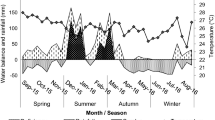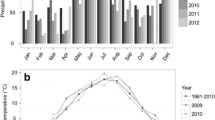Abstract
Alley cropping multi-rows of shrub willow hybrids and grassland is a promising temperate agroforestry practice for an environmentally sound provision of bioenergy feedstock. The effect of willows, aged 2–3 years, on two grassland mixtures (clover-grass, diversity oriented mixture) was determined at three positions along the tree-crop interface at a study site in Central Germany. Willows modified the incident light on understory along the interface. Biennial mean daily light integral at position south-west (SW) was 22 mol m−2 w−1, in the center of the alley 30 mol m−2 w−1 and at position north-east (NE) 26 mol m−2 w−1. Accordingly, soil temperature was lower at the positions SW and NE being adjacent to the willows. There was no clear pattern of the distribution of volumetric soil moisture content along the tree-crop interface in 15 cm depth, except that moisture content was highest in 35 cm depth at SW position in both years. In the early establishment phase, the diameter at breast height (DBH) of pooled inner willow rows (17 mm) was significantly different from pooled outer rows (21 mm). Direction had a significant influence on DBH in 2012, but not in 2013. The impact of willows on productivity of the two grassland mixtures was not confirmed until the third year after establishment. Dry matter yield was on par with those reported for single-cropped grassland adjacent to the agroforestry system. Sward composition of clover-grass changed along the tree-crop interface. Dry matter contribution of legumes was lower at the position SW. No remarkable impact of trees on quality parameters of grassland mixtures were found along the interface. Horizontal and vertical growth of the trees may modify the microclimate during the life-span of the alley cropping system consisting of willows and grassland. More research is needed on long-term monitoring of competitive, complementary and facilitative effects along the tree-crop interface.





Similar content being viewed by others
References
Albaugh JM, Albaugh TJ, Heiderman RR, Leggett Z, Stape JL, King K, O’Neill KP, King JS (2014) Evaluating changes in switchgrass physiology, biomass, and light-use efficiency under artificial shade to estimate yields if intercropped with Pinus taeda L. Agrofor Syst 88:489–503
Biewer S, Fricke T, Wachendorf M (2009) Development of canopy reflectance models to predict forage quality of legume–grass mixtures. Crop Sci 49:1917–1926
Burner DM, Belesky DP (2008) Relative effects of irrigation and intense shade on productivity of alley-cropped tall fescue herbage. Agrofor Syst 73:127–139
Burner DM, Brauer DK, Pote DH, Snider JL (2015) Effect of understory management on phenological responses of eastern black walnut on an alluvial Arkansas soil. Agrofor Syst 89:135–147
Chirko CP, Gold MA, Nguyen PV, Jiang JP (1996) Influence of direction and distance from trees on wheat yield and photosynthetic photon flux density (Qp) in a Paulownia and wheat intercropping system. For Ecol Manag 83:171–180
Delate K, Holzmueller E, Frederick D, Mize C, Brummer C (2005) Tree establishment and growth using forage ground covers in an alley-cropped system in Midwestern USA. Agrofor Syst 65:43–52
Douglas GB, Walcroft AS, Wills BJ, Hurst SE, Foote AG, Trainor KD, Fung LE (2001) Resident pasture growth and the micro-environment beneath young, wide-spaced poplar in New Zealand. Proc NZ Grassl Assoc 63:131–138
Douglas GB, Walcroft AS, Hurst SE, Potter JF, Foote AG, Fung LE, Edwards WRN, van den Dijssel C (2006a) Interactions between widely spaced young poplars (Populus spp.) and the understorey environment. Agrofor Syst 67:177–186
Douglas GB, Walcroft AS, Hurst SE, Potter JF, Foote AG, Fung LE, Edwards WRN, van den Dijssel C (2006b) Interactions between widely spaced young poplars (Populus spp.) and introduced pasture mixtures. Agrofor Syst 66:165–178
Dufour L, Metay A, Talbot G, Dupraz C (2012) Assessing light competition for cereal production in temperate agroforestry systems using experimentation and crop modelling. J Agron Crop Sci 199:217–227
Ehret M, Bühle L, Graß R, Lamersdorf N, Wachendorf M (2015a) Bioenergy provision by an alley cropping system of grassland and shrub willow hybrids: biomass, fuel characteristics and net energy yields. Agrofor Syst 89:365–381
Ehret M, Graß R, Wachendorf M (2015b) The effect of shade and shade material on white clover/perennial ryegrass mixtures for temperate agroforestry systems. Agrofor Syst 89:557–570
Ericsson N, Nordberg A, Sundberg C, Ahlgren S, Hansson PA (2012) Climate impact and energy efficiency from electricity generation through anaerobic digestion or direct combustion of short rotation coppice willow. Appl Energy 132:86–98
Gamble JD, Johnson G, Sheaffer CC, Current DA, Wyse DL (2014) Establishment and early productivity of perennial biomass alley cropping systems in Minnesota, USA. Agrofor Syst 88:75–85
Gargaglione V, Peri PL, Rubio G (2014) Tree–grass interactions for N in Nothofagus antarctica silvopastoral systems: evidence of facilitation from trees to underneath grasses. Agrofor Syst 88:779–790
Garrett HE, Kerley MS, Ladyman KP, Walter WD, Godsey LD, Van Sambeek JW, Brauer DK (2004) Hardwood silvopasture management in North America. Agrofor Syst 61:21–33
Geyer WA, Fick WH (2015) Yield and forage quality of smooth brome in a black walnut alley-cropping practice. Agrofor Syst 89:107–112
Gillespie AR, Jose S, Mengel DB, Hoover WL, Pope PE, Seifert JR, Biehle DJ, Stall T, Benjamin TJ (2000) Defining competition vectors in temperate alley cropping system in the midwestern USA: 1. Production physiology. Agrofor Syst 48:25–40
Gruenewald H, Brandt BKV, Schneider BU, Bens O, Kendzia G, Huettl RF (2007) Agroforestry systems for the production of woody biomass for energy transformation purposes. Ecol Eng 29:319–328
Guevara-Escobar A, Edwards WRN, Morton RH, Kemp PD, Mackay AD (2000) Tree water use and rainfall partitioning in a mature poplar-pasture system. Tree Physiol 20:97–106
Guevara-Escobar A, Kemp PD, Mackay AD, Hodgson J (2007) Pasture production and composition under poplar in a hill environment in New Zealand. Agrofor Syst 69:199–213
Hartmann L, Richter F, Busch Ehret M, Jansen M, Lamersdorf N (2014) Establishment of short rotation coppices in the South of Lower Saxony and in Central Thuringia in the context of the BEST-research framework-site characteristics and initial biomass production (in German only). Forstarchiv 85:134–150
Heaton EA, Dohlemann FG, Long S (2008) Meeting US biofuel goals with less land: the potential of Miscanthus. Glob Change Biol 14:1–15
Holzmueller EJ, Jose S (2012) Biomass production for biofuels using agroforestry: potential for the North Central Region of the United States. Agrofor Syst 85:305–314
IUSS Working Group WRB (2006) World reference base for soil resources (2006) A framework for international classification, correlation and communication. World Soil Resources Reports No. 103. International Union of Soil Sciences (IUSS) and Food and Agriculture Organization of the United Nations (FAO), Rome. ftp.fao.org/agl/agll/docs/wsrr103e.pdf. Accessed 6 March 2015
Jose S, Holzmueller EJ, Garrett HE, Gillespie AR (2009) Tree-crop interactions in temperate agroforestry. In: Garrett HE (ed) North American agroforestry: an integrated science and practice, 2nd edn. American Society for Agronomy, Madison, pp 57–73
Korczynski PC, Logan J, Faust JE (2002) Mapping monthly distribution of daily light integrals across the contiguous United States. Horttechnology 12:12–16
Lin CH, McGraw RL, George MF, Garrett HE (2001) Nutritive quality and morphological development under partial shade of some forage species with agroforestry potential. Agrofor Syst 53:269–281
Pollock KM, Lucas RJ, Mead DJ, Thomson SE (1994) Forage-pasture production in the first three years of an agroforestry experiment. Proc NZ Grassl Assoc 56:179–185
Pollock KM, Mead DJ, McKenzie BA (2009) Soil moisture and water use by pastures and silvopastures in a sub-humid temperate climate in New Zealand. Agrofor Syst 75:223–238
Reynolds PE, Simpson JA, Thevathasan NV, Gordon AM (2007) Effects of tree competition on corn and soybean photosynthesis, growth, and yield in a temperate tree-based agroforestry intercropping system in southern Ontario, Canada. Ecol Eng 29:362–371
Thevathasan NV, Gordon AM (2004) Ecology of tree intercropping systems in the North temperate region: experiences from southern Ontario, Canada. Agrofor Syst 61:257–268
Verwijst T, Telenius B (1999) Biomass estimation procedures in short rotation forestry. For Ecol Manag 121:137–146
Yunusa IAM, Mead DJ, Lucas RJ (1995) Process studies in a Pinus radiata-pasture agroforestry system in a subhumid temperature environment. 2. Analysis of dry matter yields in the third year. Agrofor Syst 32:185–204
Zamora D, Jose S, Napolitano K (2009) Competition for 15 N labeled nitrogen in a loblolly pine-cotton alley cropping system in the southern United States. Agric Ecosyst Environ 131:40–50
Acknowledgments
This work was funded by the German Ministry of Education and Research (BMBF) within the Framework Program Research for Sustainable Development (FONA).
Author information
Authors and Affiliations
Corresponding author
Ethics declarations
Conflict of interest
The authors declare that they have no conflict of interest.
Electronic supplementary material
Below is the link to the electronic supplementary material.
Rights and permissions
About this article
Cite this article
Ehret, M., Graß, R. & Wachendorf, M. Productivity at the tree-crop interface of a young willow-grassland alley cropping system. Agroforest Syst 92, 71–83 (2018). https://doi.org/10.1007/s10457-016-0015-z
Received:
Accepted:
Published:
Issue Date:
DOI: https://doi.org/10.1007/s10457-016-0015-z




